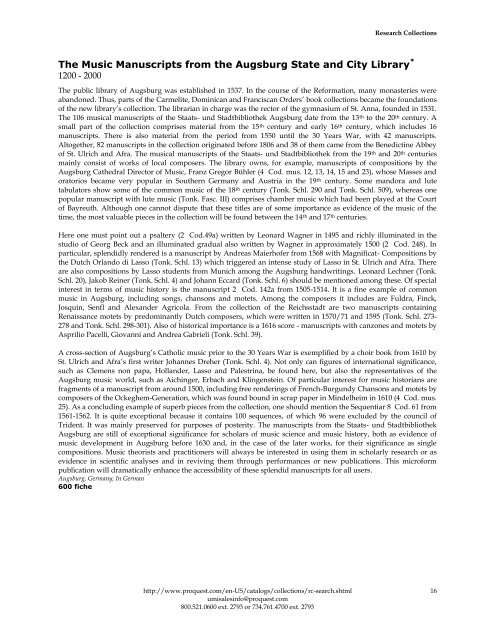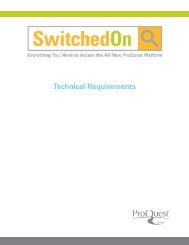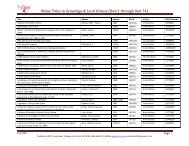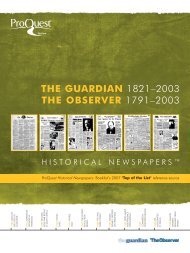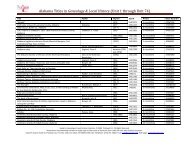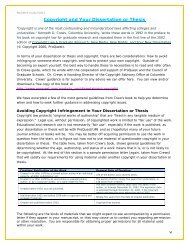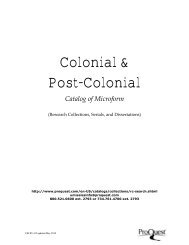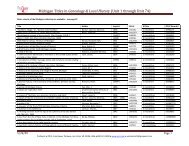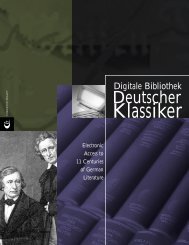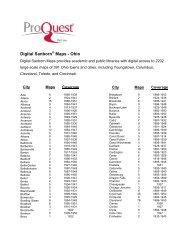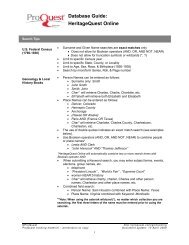ProQuest - Rare Manuscripts Catalog | Subject Catalog (PDF)
ProQuest - Rare Manuscripts Catalog | Subject Catalog (PDF)
ProQuest - Rare Manuscripts Catalog | Subject Catalog (PDF)
Create successful ePaper yourself
Turn your PDF publications into a flip-book with our unique Google optimized e-Paper software.
Research Collections<br />
The Music <strong>Manuscripts</strong> from the Augsburg State and City Library *<br />
1200 - 2000<br />
The public library of Augsburg was established in 1537. In the course of the Reformation, many monasteries were<br />
abandoned. Thus, parts of the Carmelite, Dominican and Franciscan Orders‘ book collections became the foundations<br />
of the new library‘s collection. The librarian in charge was the rector of the gymnasium of St. Anna, founded in 1531.<br />
The 106 musical manuscripts of the Staats- und Stadtbibliothek Augsburg date from the 13 th to the 20 th century. A<br />
small part of the collection comprises material from the 15 th century and early 16 th century, which includes 16<br />
manuscripts. There is also material from the period from 1550 until the 30 Years War, with 42 manuscripts.<br />
Altogether, 82 manuscripts in the collection originated before 1806 and 38 of them came from the Benedictine Abbey<br />
of St. Ulrich and Afra. The musical manuscripts of the Staats- und Stadtbibliothek from the 19 th and 20 th centuries<br />
mainly consist of works of local composers. The library owns, for example, manuscripts of compositions by the<br />
Augsburg Cathedral Director of Music, Franz Gregor Bühler (4 Cod. mus. 12, 13, 14, 15 and 23), whose Masses and<br />
oratorios became very popular in Southern Germany and Austria in the 19 th century. Some mandora and lute<br />
tabulators show some of the common music of the 18 th century (Tonk. Schl. 290 and Tonk. Schl. 509), whereas one<br />
popular manuscript with lute music (Tonk. Fasc. III) comprises chamber music which had been played at the Court<br />
of Bayreuth. Although one cannot dispute that these titles are of some importance as evidence of the music of the<br />
time, the most valuable pieces in the collection will be found between the 14 th and 17 th centuries.<br />
Here one must point out a psaltery (2 Cod.49a) written by Leonard Wagner in 1495 and richly illuminated in the<br />
studio of Georg Beck and an illuminated gradual also written by Wagner in approximately 1500 (2 Cod. 248). In<br />
particular, splendidly rendered is a manuscript by Andreas Maierhofer from 1568 with Magnificat- Compositions by<br />
the Dutch Orlando di Lasso (Tonk. Schl. 13) which triggered an intense study of Lasso in St. Ulrich and Afra. There<br />
are also compositions by Lasso students from Munich among the Augsburg handwritings. Leonard Lechner (Tonk.<br />
Schl. 20), Jakob Reiner (Tonk. Schl. 4) and Johann Eccard (Tonk. Schl. 6) should be mentioned among these. Of special<br />
interest in terms of music history is the manuscript 2 Cod. 142a from 1505-1514. It is a fine example of common<br />
music in Augsburg, including songs, chansons and motets. Among the composers it includes are Fuldra, Finck,<br />
Josquin, Senfl and Alexander Agricola. From the collection of the Reichsstadt are two manuscripts containing<br />
Renaissance motets by predominantly Dutch composers, which were written in 1570/71 and 1595 (Tonk. Schl. 273-<br />
278 and Tonk. Schl. 298-301). Also of historical importance is a 1616 score - manuscripts with canzones and motets by<br />
Asprilio Pacelli, Giovanni and Andrea Gabrieli (Tonk. Schl. 39).<br />
A cross-section of Augsburg‘s Catholic music prior to the 30 Years War is exemplified by a choir book from 1610 by<br />
St. Ulrich and Afra‘s first writer Johannes Dreher (Tonk. Schl. 4). Not only can figures of international significance,<br />
such as Clemens non papa, Hollander, Lasso and Palestrina, be found here, but also the representatives of the<br />
Augsburg music world, such as Aichinger, Erbach and Klingenstein. Of particular interest for music historians are<br />
fragments of a manuscript from around 1500, including free renderings of French-Burgundy Chansons and motets by<br />
composers of the Ockeghem-Generation, which was found bound in scrap paper in Mindelheim in 1610 (4 Cod. mus.<br />
25). As a concluding example of superb pieces from the collection, one should mention the Sequentiar 8 Cod. 61 from<br />
1561-1562. It is quite exceptional because it contains 100 sequences, of which 96 were excluded by the council of<br />
Trident. It was mainly preserved for purposes of posterity. The manuscripts from the Staats- und Stadtbibliothek<br />
Augsburg are still of exceptional significance for scholars of music science and music history, both as evidence of<br />
music development in Augsburg before 1630 and, in the case of the later works, for their significance as single<br />
compositions. Music theorists and practitioners will always be interested in using them in scholarly research or as<br />
evidence in scientific analyses and in reviving them through performances or new publications. This microform<br />
publication will dramatically enhance the accessibility of these splendid manuscripts for all users.<br />
Augsburg, Germany; In German<br />
600 fiche<br />
http://www.proquest.com/en-US/catalogs/collections/rc-search.shtml 16<br />
umisalesinfo@proquest.com<br />
800.521.0600 ext. 2793 or 734.761.4700 ext. 2793


